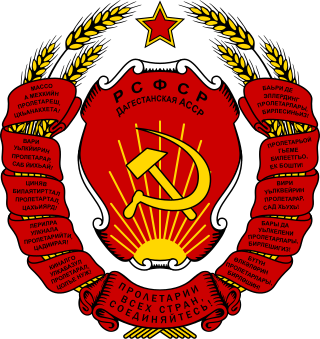
Dagestan, officially the Republic of Dagestan, is a republic of Russia situated in the North Caucasus of Eastern Europe, along the Caspian Sea. It is located north of the Greater Caucasus, and is a part of the North Caucasian Federal District. The republic is the southernmost tip of Russia, sharing land borders with the countries of Azerbaijan and Georgia to the south and southwest, the Russian republics of Chechnya and Kalmykia to the west and north, and with Stavropol Krai to the northwest. Makhachkala is the republic's capital and largest city; other major cities are Derbent, Kizlyar, Izberbash, Kaspiysk and Buynaksk.

Khizi District is one of the 66 districts of Azerbaijan. It is located in the east of the country and belongs to the Absheron-Khizi Economic Region. The district borders the districts of Siyazan, Shabran, Quba, Shamakhi, Gobustan, and Absheron-Khizi. Its capital and largest city is Khizi. As of 2020, the district had a population of 17,100, making it the least populated district of Azerbaijan.
Tabasaran is a Northeast Caucasian language of the Lezgic branch. It is spoken by the Tabasaran people in the southern part of the Russian Republic of Dagestan. There are two main dialects: North (Khanag) and South Tabasaran. It has a literary language based on the Southern dialect, one of the official languages of Dagestan.
Tabasaran or Tabassaran may refer to:

Tabasarans are a Northeast Caucasian ethnic group native predominantly to southern part of the North Caucasian Republic of Dagestan. Their population in Russia is about 150,000. They speak the Tabasaran language. They are mainly Sunni Muslims.
Azerbaijanis in Russia or Russian Azerbaijanis are people of Azeri descent in Russia. These may be either ethnic Azeris residents in the country or recent immigrants who profess Azeri ancestry.

Shaykh Haydar or Sheikh Haydar was the successor of his father as leader of the Safavid order from 1460-1488. Haydar maintained the policies and political ambitions initiated by his father. Under Sheikh Haydar, the order became crystallized as a political movement with an increasingly extremist heterodox Twelver Shi'i coloring and Haydar was viewed as a divine figure by his followers. Shaykh Haydar was responsible for instructing his followers to adopt the scarlet headgear of 12 gores commemorating The Twelve Imams, which led to them being designated by the Turkish term Qizilbash "Red Head".

Agulsky District is an administrative and municipal district (raion), one of the forty-one in the Republic of Dagestan, Russia. It is located in the south of the republic. The area of the district is 793.5 square kilometers (306.4 sq mi). Its administrative center is the rural locality of Tpig. As of the 2010 Census, the total population of the district was 11,204, with the population of Tpig accounting for 24.4% of that number.

The national emblem of the Dagestan Autonomous Soviet Socialist Republic was adopted in 1937 by the government of the Dagestan Autonomous Soviet Socialist Republic. The emblem is identical to the emblem of the Russian Soviet Federative Socialist Republic.
Amukh is a rural locality and the administrative centre of Amukhsky Selsoviet, Agulsky District, Republic of Dagestan, Russia. The population was 118 as of 2010.
Arsug is a rural locality in Burshagsky Selsoviet, Agulsky District, Republic of Dagestan, Russia. The population was 238 as of 2010.
Goa is a rural locality in Burshagsky Selsoviet, Agulsky District, Republic of Dagestan, Russia. The population was 475 as of 2010.
Yarkug is a rural locality in Burshagsky Selsoviet, Agulsky District, Republic of Dagestan, Russia. The population was 340 as of 2010.
Bedyuk is a rural locality in Richinsky Selsoviet, Agulsky District, Republic of Dagestan, Russia. The population was 305 as of 2010.
Pervomayskoye is a rural locality in Kosyakinsky Selsoviet, Kizlyarsky District, Republic of Dagestan, Russia. The population was 945 as of 2010. There are 9 streets.
Rybalko is a rural locality in Krasnoarmeysky Selsoviet, Kizlyarsky District, Republic of Dagestan, Russia. The population was 1,787 as of 2010. There are 14 streets.
Ukrainskoye is a rural locality in Chernyayevsky Selsoviet, Kizlyarsky District, Republic of Dagestan, Russia. The population was 209 as of 2010. There is 1 street.
Mirza Hasan Alkadari — Islamic jurist (faqih), historian, poet, educator in pre-revolutionary Dagestan.
Khanzhalkala (Khandzhel-Kala), also known as Khanjal-Kala is an abandoned Lezgin aul in the Magaramkentsky District of Dagestan. The name comes from Judeo-Tat and means "fortress of the dagger". It was protected not only by the steep slopes of the mountain on which it was located, but also by its fortress walls. It was abolished in 1968.

Judaism in Dagestan is mainly practiced by Mountain Jews. Beginning of the 8th century BCE, Mountain Jews had reached Persia from Israel. During the reign of the Sasanian Empire, with the infiltration of Iranian-speaking tribes into Dagestan from the north, they settled in different regions of the Caucasus.







